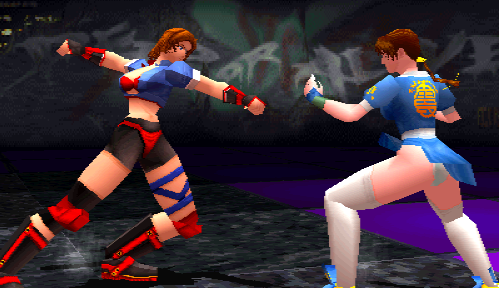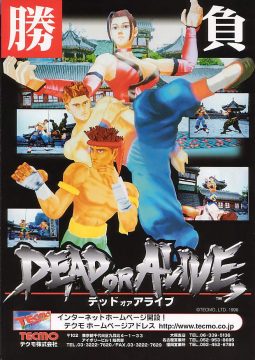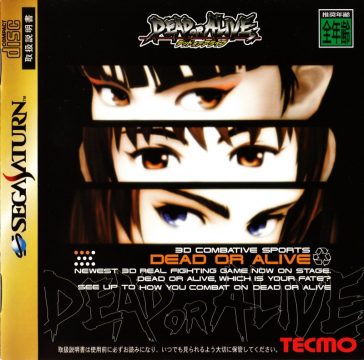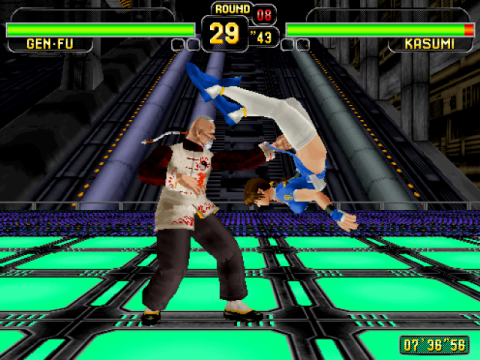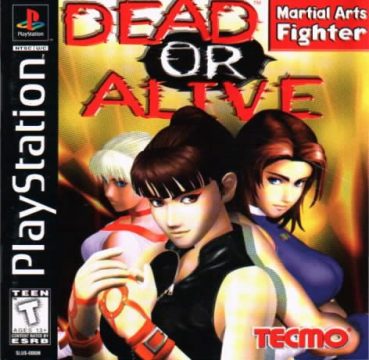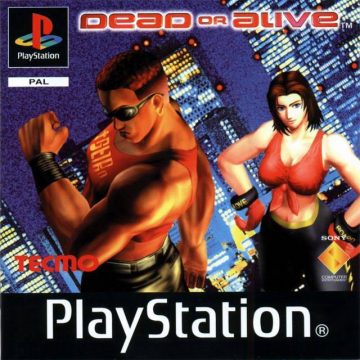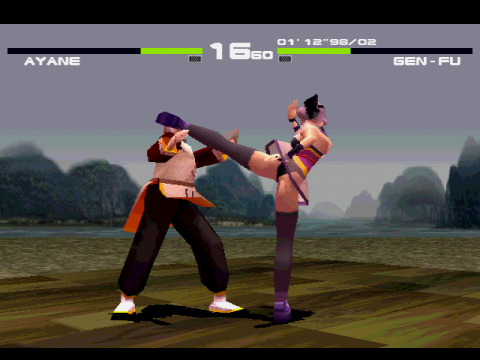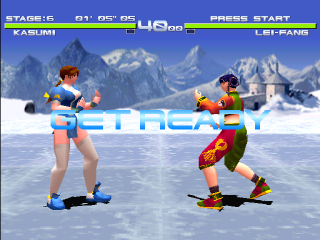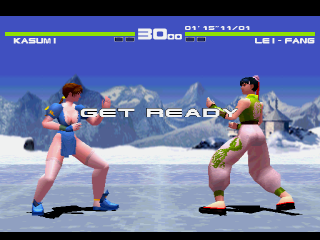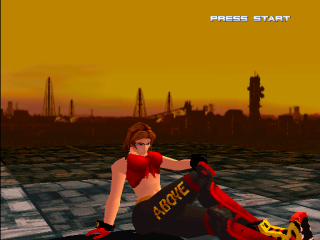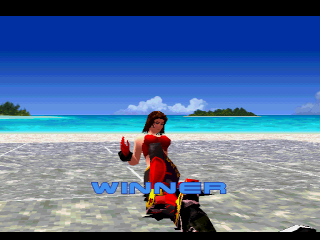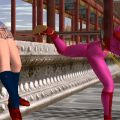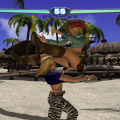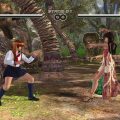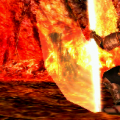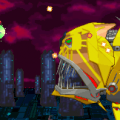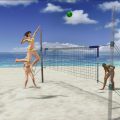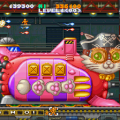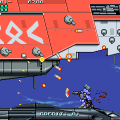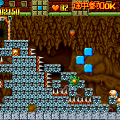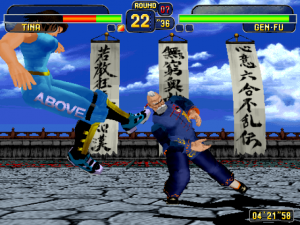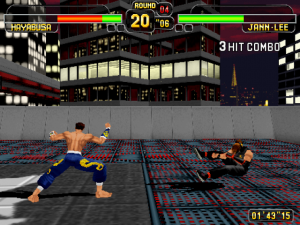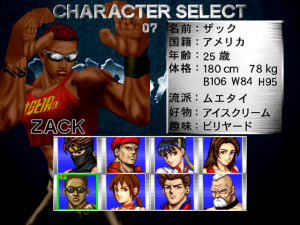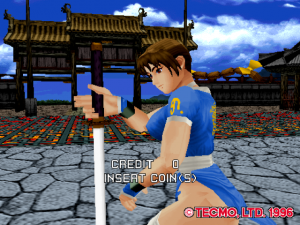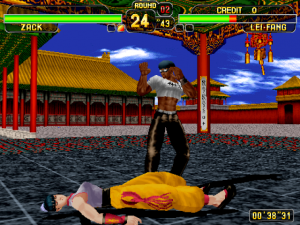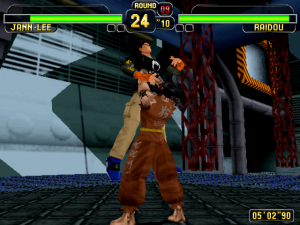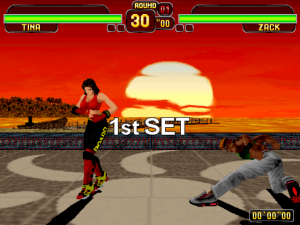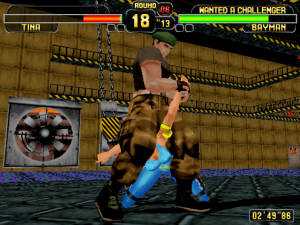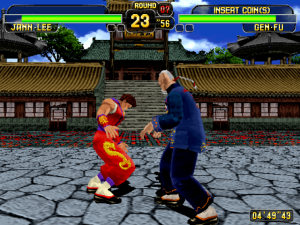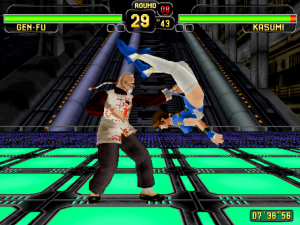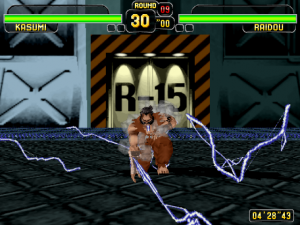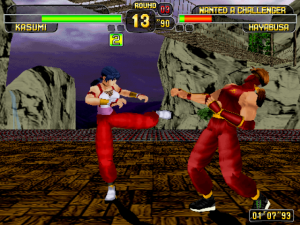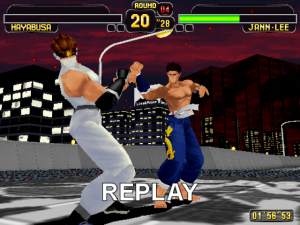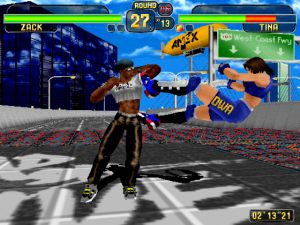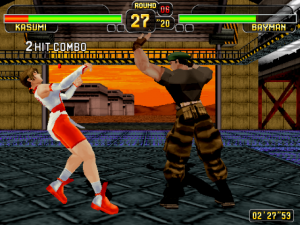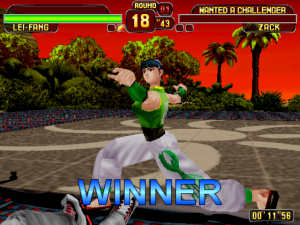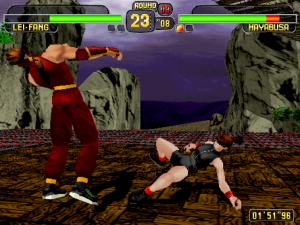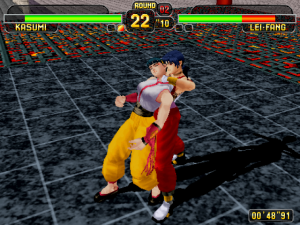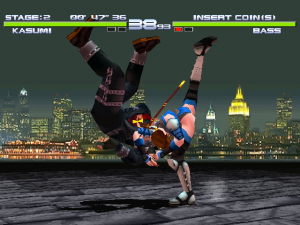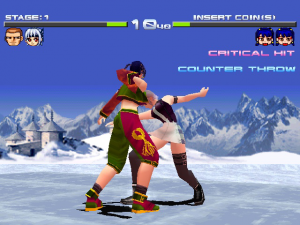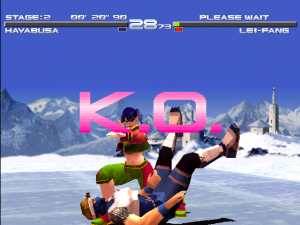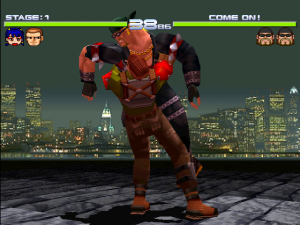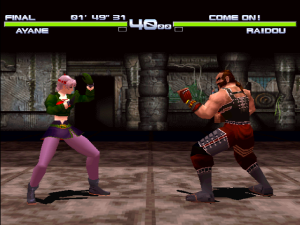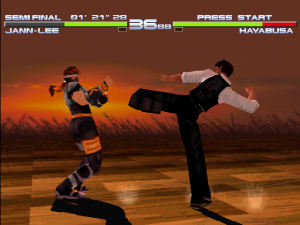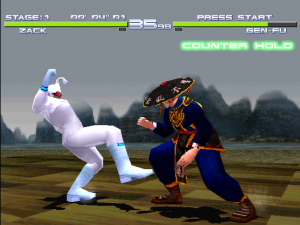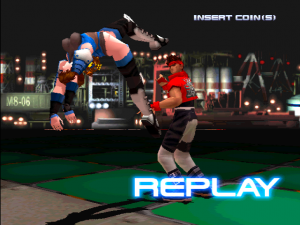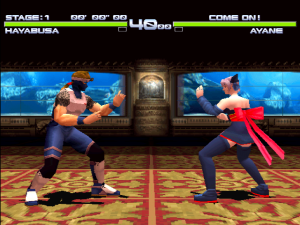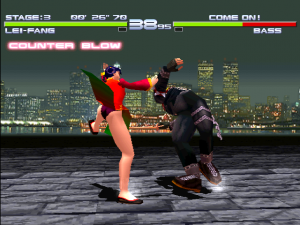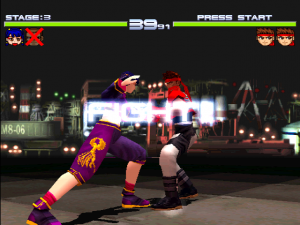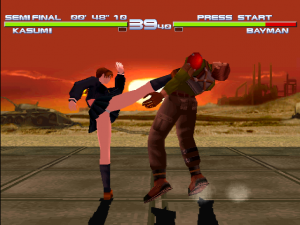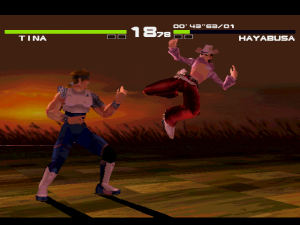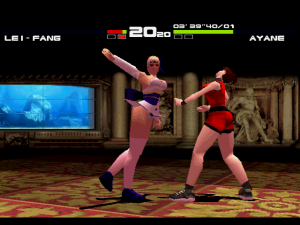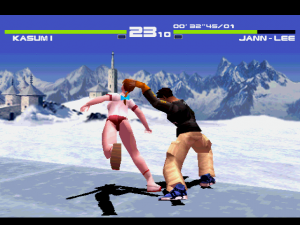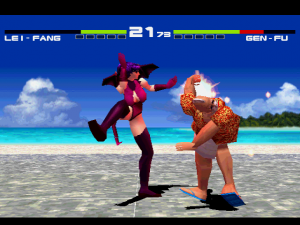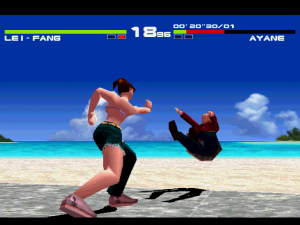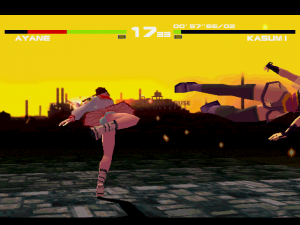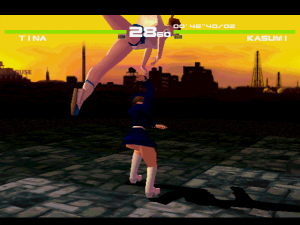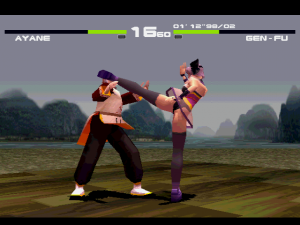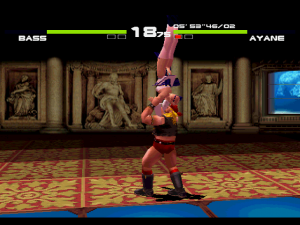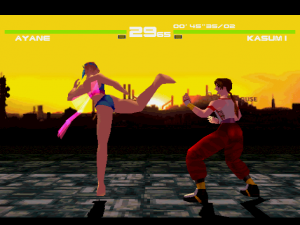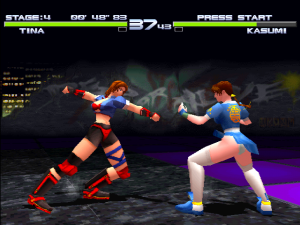The original version of Dead or Alive was first released in the arcades on Sega’s Model 2. It’s the same board used for Virtua Fighter 2, and Dead or Alive almost looks like a sequel or spin-off to that series. The achievement that bought Dead or Alive the attention was the graphics. Its fully 3D backgrounds maybe couldn’t hold the candle against the detailed environments Virtua Fighter 3 was able to do at the same time due to running on the improved Model 3 hardware, but they feature some neat effects of objects like roofs and bridges directly above the fighting arena. The characters, on the other hand, were even finer modeled than in Sega’s flagship fighting game. The game was also quite infamous for its exorbitant soft object physics, which was not limited to get hair and clothes moving. Female bust animation was done before in 3D games, keen eyes can spot subtle movements on Soul Blade‘s Taki in the arcades. The way, however, in which Dead or Alive shoved the facts in players’ faces, caused a lot of excitement, positive and negative.
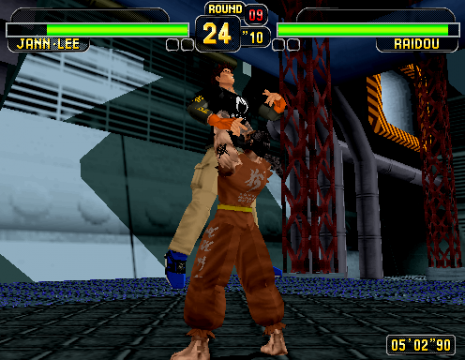
Arcade
The gameplay doesn’t distinguish itself too much from Virtua Fighter yet, either. Dead or Alive offers eight playable characters and a boss character, none of which display any spectacular innovation. Just like Virtua Fighter, it relies on three buttons for punches, kicks and blocking, where combinations of the three can be used for more powerful moves, particularly punch and block for throws. The throwaround in the formula comes with the Danger Zone – a large portion of the perimeter of the ring is laced with explosives, so if you knock your opponent to the ground, you can inflict extra damage, and usually cause them to skyrocket straight into the air.
The game also already has a simple counter system. The so-called ‘holds’ are an easy-to-execute command used to intercept the opponent’s attack. This was used to implement the rock-paper-scissors system that would become a staple for the entire series, namely counters beating normal attacks, throws beating counters, and normal attacks beating throws. In contrast to later updates, most holds were used as openers for your own combos with little to no own damage rather than the devastating throws they are known as from Dead or Alive 2 onwards.
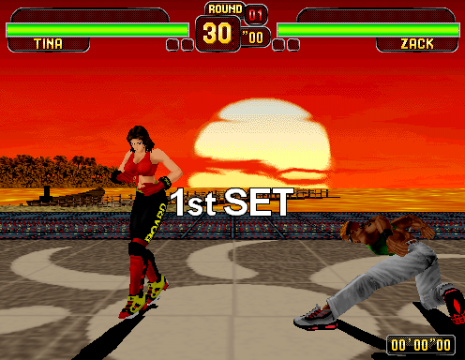
Arcade
Dead or Alive was soon ported to the Sega Saturn. The Saturn version sacrifices the 3D stages to replace them with a flat bitmap image in the background, and the character models aren’t quite as detailed, but it’s still top of the line. This is, quite simply, the finest looking 3D title on the Saturn, especially considering that the system is not known for producing decent-looking polygons. The enormous jiggliness totally crosses the line of absurdity, but the “Bouncing Breast” option can be turned off if it annoys you.
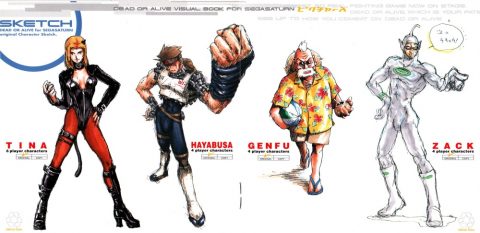 Unfortunately, the game is pretty light on modes – there’s the usual arcade, training and time attack, but there’s no real endings, another feature that didn’t make the transition from the arcade original, which at least offered a screen of plain text on a black background to elaborate on the chosen character’s fate after the tournament. Beating the game on the Saturn will unlock a few costumes and extra options, but otherwise there’s not much incentive to play the single player modes over and over. Still, it’s a great start to a great series.
Unfortunately, the game is pretty light on modes – there’s the usual arcade, training and time attack, but there’s no real endings, another feature that didn’t make the transition from the arcade original, which at least offered a screen of plain text on a black background to elaborate on the chosen character’s fate after the tournament. Beating the game on the Saturn will unlock a few costumes and extra options, but otherwise there’s not much incentive to play the single player modes over and over. Still, it’s a great start to a great series.
The Saturn version also features a redbook audio soundtrack with higher quality music, as well as a crappy animated FMV intro. Besides the regular version, it was also sold in a special edition, but the only extra was a booklet with insubstantial thumbnail images of the FMV, four pages of interesting concept art of the added costumes and a rather scandalous image of Kasumi on the CD.
Dead or Alive was also included in the Dead or Alive Ultimate collection. This is based on Itagaki’s alleged favorite version from the Saturn. Contrary to the awesome treatment Dead or Alive 2 got for the package, the term “Ultimate” seems wildly misplaced here. It’s just a direct port with no extras. Neither the 3D backgrounds of the arcade version are present, nor the characters and costumes that were added on PlayStation. This version can also be played in HD on the Xbox360, but then the low resolution of the 2D backgrounds really shows in comparison to the sharply rendered 3D characters.
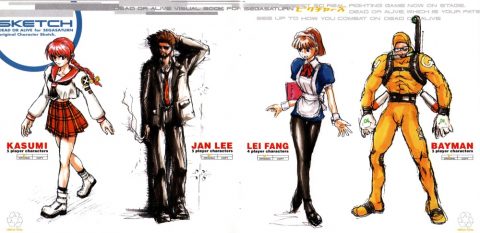
Comparison Screenshots
Dead or Alive / Dead or Alive++ – PlayStation, Arcade (1998)
When Tecmo brought Dead or Alive to the PlayStation, they didn’t just port it, but practically made it into a semi-sequel. The graphics this time are even better than on Saturn – as its predecessor, Dead or Alive is one of the smoothest, most gorgeous games on the original PlayStation, benefiting from even better character models and some shading to round the edges. All of the backgrounds have been changed, and while the Saturn version retained the themes of the original stages, this port replaces them with completely new – sometimes uninspired looking – wallpapers. Also included are several new music tracks, including the most porn-esque piece of music you’ll hear come out of a PlayStation, complete with orgasmic moaning.
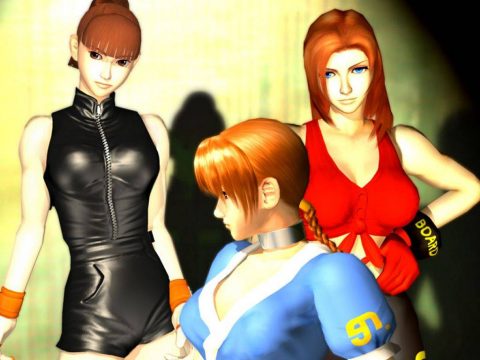
Two new characters have been added as well – Bass, the gigantic wrestler, and Ayane, the secret purple haired ninja girl. Alas, there are still no real endings for the characters, but on the flipside, the game offers a lot of costumes to unlock. Most of the male characters don’t have very many, but the women have up to 14 each.
This version was also brought to the arcades as Dead or Alive++, but not without a few more major changes. The gameplay now began a shift towards what resulted in Dead or Alive 2, giving it a very fluent feel and revising the counter system. For the first time, there is a tag mode available, though it still is nothing more than playing the next round as another character, similar to The King of Fighters (only 2-on-2 instead of 3-on-3). The arcade release lost all the unlockables from the PlayStation, stepping down to a total of four costumes per character, which are freely selectable from the start. Kasumi even gets a vaguely ninja-ish outfit, which isn’t in any of the other games. On the other hand, it reinstates the text endings that had been in the Model 2 version but were taken out on consoles.
Comparison Screenshots
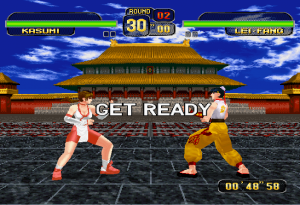
Saturn
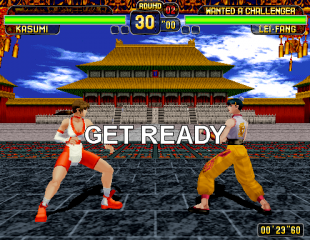
Arcade
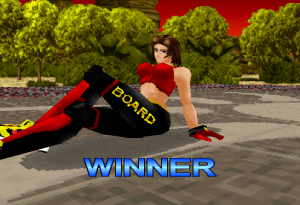
Saturn
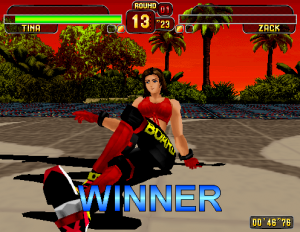
Arcade
